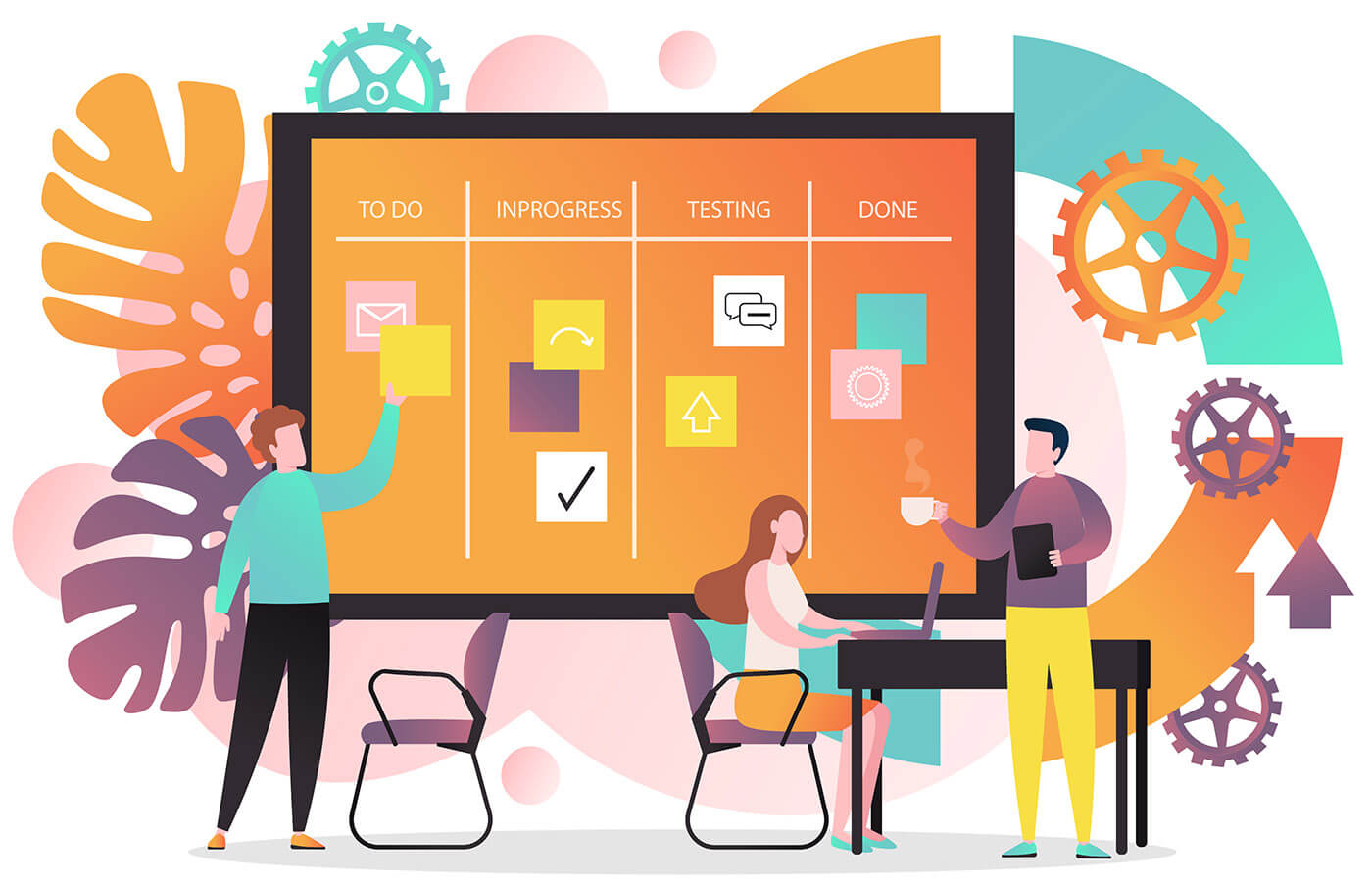Top Project Management Trends and How to Make Them Work for You
The year 2020 has put many personal lives on hold, and it has drastically changed how most businesses operate. But are these changes here to stay?
Based on our industry insight, we have evaluated some of the top project management trends that have hit in 2020. Based on our current assessment, here are the areas that your project manager should be focused on:

1. For Productivity Focus on Wellbeing
According to the World Health Organization (WHO), a negative work environment can lead to negative physical and mental health problems. Anxiety and depression actually have a significant economic impact in addition to being a health stressor. WHO estimates that $1 trillion in productivity is lost per year due to mental health issues like anxiety and depression.
So in addition to poor personal health, mental health (regardless of whether or not the work environment was the cause of it) has a drastic financial effect on a company.
While work may not necessarily be the cause of negative well-being, there are risk factors associated with work-related stressors, and minimizing these risk factors can reduce stress levels and improve productivity.
Risk factors include:
- Inadequate or poor policies for workplace health and safety
- Poor practices related to management or communication
- Limited decision-making capabilities
- Low or limited employee support
- Strict work hours
- Organization objectives that are unclear or broken
If a person is negatively affected by these risk factors, then they may not feel supported or competent in completing a task, even if they are entirely capable of doing so. This can lead to a decline in project completion rates and less project success.
We understand that reducing these risk factors might be easier said than done.
However, academic research suggests that a three-pronged approach can be an effective intervention: reducing work-related risk factors through testing, employee feedback, and outside support; developing positive work programs as well as programs that support employee strengths; and addressing mental health openly.
Project managers should consider ways to improve wellbeing in the workplace. Adopting awareness strategies is a great place to start in improving workplace mental health. Your employees want to know that you care about mental health and that you are willing to put in the time to reduce risk factors.
This does not necessarily mean that you need to change everything about your project management style in order to improve mental wellbeing, but you may need to consider a more agile and open management style. To start, adopting a culture of trust will also show employees that they have a greater level of control in their work-life.
By focusing on trust and on solutions that work for your employees, you will see a better employee-management relationship and more positive employee engagement. This also allows your team to focus less on micromanagement and more on project success.
2. Embrace Emerging Technologies
For the most part, project management, as a sector, has embraced technology in order to streamline the operational side of project progression. However, as we know, these technologies aren’t perfect.
Where technology driven by artificial intelligence (AI) technology might excel in your business process, you may find that it is lacking in automation. And, on the flip side, automation might be doable but it takes a lot of time and effort to set up.
Therefore, implementing any new technology can drastically affect project delivery timelines or success. Add this to the potential downtime of virtual teams, and you might be dissuaded from implementing any heavy-duty project management tools.
Statistics show that while there has been pushback around project management technologies, both SMBs and large corporations are relying on technology, specifically machine learning, in order to grow. This is primarily due to the growth of digital marketing. According to PWC, project management software was found to increase performance for 77% of high performing projects. However, it was also uncovered that 44% of project managers do not believe in using the software.
It is hard to grapple with these statistics, especially considering that companies who invest in project management software waste 28 times less money because their projects are completed more successfully and efficiently.
Unfortunately, the market for project management software is at a crossroads——while we know project management software to be successful, it is relying largely on emerging tech such as machine learning, which takes a lot of time to develop. Therefore, as potential consumers (or investors), purchasing a product like a first-gen project management software might be risky, but it pays off in the long run. This is because you are investing in the growth of management software, and improvements will slowly start to be implemented.
Another way to think about this is by developing an Agile Approach, a familiar process in the realm of software development. Implementing project management software integration with the agile approach might involve:
- Continual feedback/collaboration from customers
- A strong focus on learning to improve, rather than convention
- Embracing customer discovery and organically managing projects
- Potentially change management for a given project
- Potentially change the project management tool for a given project
- Agile, long-term campaigns
- Flexibility (as opposed to sticking with a firm project plan)
- Smaller experiments instead of a larger gamble
Adopting an agile methodology will not only adjust the process for how something is completed, but it will also encourage knowledge, skillsets, and models from outside the normal area of research. It is also informed largely by big data and predictive analytics.
A project manager who embraces an agile or hybrid project management style might see a lot of shifting in how a project is completed. As long as this precedent is set with the employee, then adapting to regular changes in order to streamline a project workflow will become second nature.
3. Be Open to Distributed Teams

Working with a distributed team, remote team, and/or hybrid team can benefit a company in many ways. If this style of hiring is possible, your business can expand your services or products, as well as open up more hours for customer communication, logistical concerns, and other international business ventures.
However, managing a remote team might be difficult. A project manager in charge of a distributed team will have to adapt normal processes to account for things like a difference in time zone, unusual workspace factors, added distractions or home stressors, weak or faulty networks, poor productivity, and much more.
If you’re stuck trying to progress projects with a distributed team, you could try the following tactics:
- Set up guidelines that openly account for things like time difference and workspaces
- Encourage a culture of accountability
- Encourage open communication and collaboration
- Regularly check-in with employees
- Streamline communication
- Try video meetings regularly
- Adopt project management software
- Implement employee monitoring software
- Start engaging in leadership development for some of your top talent
If you find that implementing a distributed team is more effective for your company, or if your company is forced to move your employees to remote work due to the COVID-19 pandemic, then you’ll need to put some thought into how best project management should operate.
Additionally, when considering development processes, make sure to take time to understand the daily employee experience, employee productivity, and customer experience. If these performance variables are negative, then you might have to assess whether or not your company goes through a development process or not.
4. Revert Back to Longest Processing Times
New trends suggest that due to shifts in how all businesses operate communication processes change, either because of new technologies or remote-related issues. This means that both employees and upper-level management need enough time to make weightier decisions.
This also suggests that micromanaging a team may not prove effective. An employee needs more time to process the specs of a project, the politics involved with decision making, and other personal decisions.
Timelines have been drastically altered due to the disruption of the COVID-19 global pandemic. Not only have companies been reeling because of this major economic shift, but they are still trying to identify if processes that were in place before the pandemic still hold.
So what are the key takeaways from this? Well, for starters, you can expect the communication process for business-to-business (B2B), business-to-customer (B2C), and business-to-employee (B2E) to slow way down. This is because like yourself, other organizations are forced to remote working, hybrid methodologies, and other new processes.
Unfortunately, the weight of the global economic shutdowns is affecting companies across the board. So, if you don’t ever respond to a client or other business, then there could be worries that your company has shut down.
Offering automated updates to let your recipients know you’re there is nice, but it is also understood if a response does not come right away. Regularly responding to any form of communication, no matter what the purpose or timeline, will also set the precedent that you are still with the community.
5. More Forgiveness in Business Relationships
Businesses of all sizes are feeling the weight of the economic shift. Even after we emerge from this time of uncertainty, many companies will remember that this was not business as usual.
Businesses have experienced an extreme range of stressors—from shutting down completely, to letting go of numerous employees. Businesses have also been forced to completely change how their products, and/or services are offered. Therefore, companies have been openly asking for patience and forgiveness in all areas of operations.
With all this said, know that failure is an option. With lots of things changed and changes happening every day, it is only natural to fail. Not one person or company is expected to be completely aware or ready for the changes that are coming our way or even prepared for the changes that we’ve already experienced.
By adopting forgiveness in your model of project management, you are also setting up expectations for future growth. By doing this, employees will understand when it is okay to try or fail, and that learning something new is part of the job. This creates an open and more welcoming environment that facilitates diversity, growth, and compassion.
The Big Picture
If your business is surviving, then you’ve already learned that adapting your project managing processes is mandatory. Plan to do the following to promote project success:
- Implement software designed for project management or task management
- Regularly check in with your team, especially for remote workers
- Adopt an agile project management technique
- Encourage collaboration in developing a project plan and project delivery
- You may want to reconsider your project work-flow or project methodology
- Focused on design thinking or design problem solving
The year 2020 was already expected to see major shifts in project management trends. However, with the emergence of the COVID-19 global pandemic and the major hit incurred by the global economy, businesses have been forced into a new way of living.
Continue to practice these top management trends in order to keep your team ahead of the curve.
By SoftActivity Team